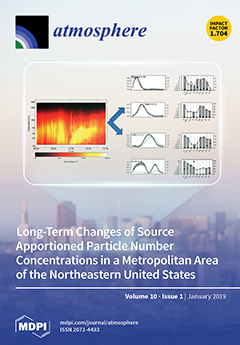Anhui is one of the highest provincial emitters of air pollutants in China due to its large coal consumption in coal-fired plants. In this study, the total emissions of nitrogen oxides (NO
x), sulfur dioxide (SO
2) and particulate matter (PM)
[...] Read more.
Anhui is one of the highest provincial emitters of air pollutants in China due to its large coal consumption in coal-fired plants. In this study, the total emissions of nitrogen oxides (NO
x), sulfur dioxide (SO
2) and particulate matter (PM) from coal-fired power plants in Anhui were investigated to assess the impact of control measures on the atmospheric emissions based upon continuous emission monitoring systems (CEMS). The total NO
x, SO
2 and PM emissions significantly decreased from 2013 to 2017 and they were estimated at 24.5 kt, 14.8 kt and 3.0 kt in 2017, respectively. The emission reductions of approximately 79.0%, 70.1% and 81.2% were achieved in 2017 compared with a 2013 baseline, respectively, due to the application of high-efficiency emission control measures, including the desulfurization, denitration and dust-removing devices and selective catalytic reduction (SCR). The NO
x, SO
2 and PM emission intensities were 0.125 g kWh
−1, 0.076 g kWh
−1 and 0.015 g kWh
−1 in 2017, respectively, which were lower than the average of national coal-fired units. The coal-fired units with ≥600 MW generated 80.6% of the total electricity amount while they were estimated to account for 70.5% of total NO
x, 70.1% of total SO
2 and 71.9% of total PM. Their seasonal emissions showed a significant correlation to the power generation with the maximum correlation found in summer (July and August) and winter (January and December). The major regional contributors are the cities along the Huai River Basin and Yangtze River Basin, such as Huainan, Huaibei, Tongling, Maanshan and Wuhu, and the highest emission occurred in Huainan, accounting for approximately 26–40% of total emission from all the power plants. Our results indicated that the application of desulfurization, denitration and dust-removing devices has played an important role in controlling air pollutant emissions from coal-fired power plants.
Full article


